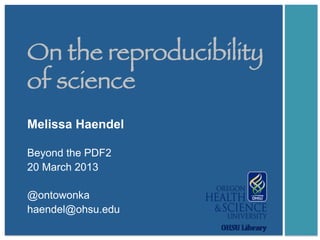
On Reproducibility of Science: Half of Antibodies Not Identifiable
- 1. On the reproducibility of science Melissa Haendel Beyond the PDF2 20 March 2013 @ontowonka haendel@ohsu.edu
- 2. The science cycle Slide from Gully Burns Do we know if the infrastructure is actually broken?
- 3. The science cycle Image: h6p://www.joinchangena=on.org/blog/post/roadblocks-‐on-‐the-‐pathway-‐to-‐ci=zenship This is a broken data story.
- 4. Reproducibility is dependent at a minimum, on using the same resources. But… “All companies from which materials were obtained should be listed.” -‐ A well-‐known journal Journal guidelines for methods are often poor and space is limited
- 5. Hypothesis: AnAbodies in the published literature are not uniquely idenAfiable Gather journal ar=cles 28 Journals Iden=fying ques=ons: 5 domains: Is the an=body iden=fiable Immunology 119 papers in the vendor site? Cell biology Neuroscience Is the catalog number Developmental biology 454 an=bodies reported? General biology 408 commercial an=bodies Is the source organism 3 impact factors: reported? High 46 non-‐commercial Medium an=bodies Low Is the an=body target iden=fiable? An experiment in reproducibility
- 6. Approximately half of anAbodies are not uniquely idenAfiable in 119 publicaAons 60% n=46 50% Percent idenAfiable n=408 40% 30% 20% 10% 0% Commercial an=body Non-‐commerical an=body The data shows…
- 7. Unique idenAficaAon of commercial anAbodies varies across discipline and impact factor 100% n=87 90% 80% n=95 Percent iden=fiable 70% 60% n=94 High 50% n=124 n=56 Medium 40% Low 30% 20% 10% 0% Immunology Neuroscience Dev Bio Cell Bio General Bio In some domains high impact journals have worse reporting, and in others it is the opposite
- 8. Maybe labs are just disorganized?
- 9. Meet the Urban Lab
- 10. Image: Gourami Watcher Meet the Urban Lab
- 11. The Urban lab anAbodies A+ organization!
- 12. 90% 80% 70% Percent idenAfiable 60% 50% 40% 30% 20% 10% 0% Commerical Ab Non-‐commercial Catalog number Source organism Target uniquely iden=fiable Ab iden=fiable reported reported iden=fiable Of 14 antibodies published in 45 articles, only 38% were identifiable
- 13. What does this tell us?
- 14. Scientists really do put their data in cardboard boxes.
- 15. Ø Promote beJer reporAng guidelines in journals Ø Include reviewing guidelines Ø Provide tools to reference research resources with unique and persistent IDs/URIs Ø Train librarians and other data stewards to apply data standards What are we going to do about it?